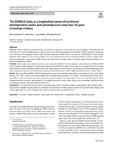2022-01-18Zeitschriftenartikel
The DONALD study as a longitudinal sensor of nutritional developments: iodine and salt intake over more than 30 years in German children
Remer, Thomas
Hua, Yifan
Esche, Jonas
Thamm, Michael
Purpose:
Mild-to-moderate iodine deficiency was present in large parts of Germany up to the beginning 1990s and improved from then on. Current epidemiological data on spot urine iodine measurements in German children strongly suggest the re-occurrence of an impaired iodine status. We thus examined whether this re-occurrence is identifiable in more detail, through iodine analyses of 24-h urine samples of a well-characterized cohort of German children in whom samples have been systematically collected from 1985 onward. As iodized salt is a major source for iodine supply, urinary sodium excretion was additionally studied.
Methods:
Daily iodine and sodium excretions were measured in 2600 24-h urine samples collected between 1985 and 2018 by 677 healthy children aged 6–12 years (participants of the DONALD study). These data were compared with 24-h iodine and sodium excretion estimates obtained from spot urine samples collected in the representative German Health Interview and Examination Surveys for Children and Adolescents KiGGS-baseline (2003–2006) and KiGGS-wave-2 (2014–2017).
Results:
Between 1985 and1992, DONALD participants started with a median daily iodine excretion level of 40.1 µg/d. Then, during 1993–2003, iodine excretions mounted up to an approximate plateau (~ 84.8 µg/d). This plateau lasted until 2012. Thereafter, iodine concentrations started to decrease again resulting in a median iodine excretion of only 58.9 µg/d in 2018. Sodium excretion, however, had increased. The marked decrease in iodine status along with an abundant sodium excretion corresponded closely with nationwide KiGGS data.
Conclusions:
As exemplified for the clearly worsening iodine status in German children, longitudinal cohort studies collecting detailed biomarker-based prospective data have the potential to reliably capture health-relevant nutritional changes and trends, applicable on a more comprehensive and even representative population level.
Dateien zu dieser Publikation

